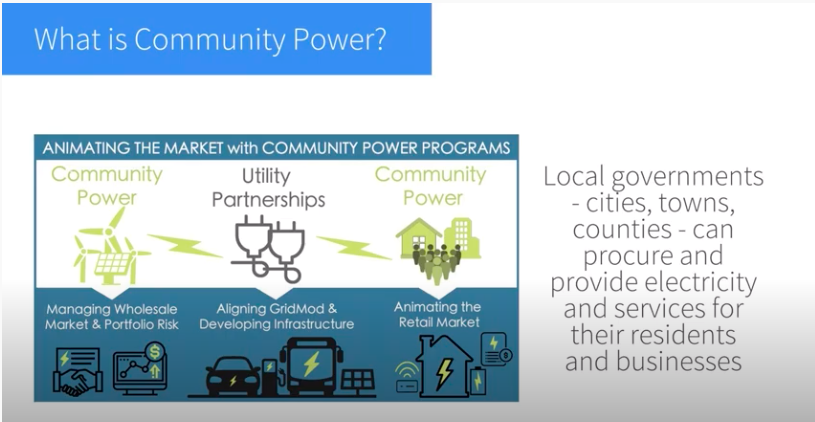Background: Purchasing Power in Bulk
Electrical power purchasing agreements have been used in New Hampshire by municipal entities and large businesses to set predictable costs and savings for some time. For example, in Peterborough, the school system contracted with the power purchasing aggregator Standard Power to supply their power needs. Eversource supplies the polls and wires but Standard Power contracts for the power supplied via the poles and wires to the school system.
Now, this type of bulk power purchasing is available at the community level in New Hampshire. While details are still be ironed out – here is what we know so far and why it is important for all Granite Staters to become familiar with the term Community Power.
What is Community Power?
In October 2019 the statehouse passed SB 286 which allowed for more flexibility for groups purchasing of electrical power within the state. The legislators termed this new power purchasing, Community Power. This allows municipalities the ability to purchase power for its residents and possibly offer other initiatives and programs through the Community Power Program.
How does Community Power work?
The law defines how governing body (town, city, or county for example) could create a Community Power Committee. This committee could be an existing committee, such as an energy committee provided with additional new directives, or a new committee, formed for the purpose of developing the Community Power Plan.
The Plan would need to include the following according to the state law:
- Universal Access to all those within the governing body
- Reliable service to the community served by the plan (typically residents and businesses)
- Equitable treatment for all those served by the plan – this may be especially important for larger groups (when more than one town or city joins together to form a larger entity) that may have more than one utility serving plan customers. It also needs to treat any special groups within the community fairly (see below – net-metered homes or fuel assistance homes)
- Meet all minimum environmental and service standards set by the Public Utility Commission (PUC) and any other relevant agencies
The Plan must also allow define
- Organizational structure and operation of the Community Power Committee
- Funding for all dollars not part of the power supplied to plan participants itself – such as administrational needs
- Rate setting for the purchased power and other costs to the plan participants
- Right and responsibilities of all program participants
- Include net-metering into the plan to take into account any net-meters participants may have – such as a resident of a municipality. For example, someone who has installed solar panels will have a net-meter attached to their home. Any agreement must define how these residents will sell back excess power.
- How to ensure all those participants in the Electric Assistance Program will still benefit. This means that all those living in the community that takes advantage of electrical assistance cannot see their benefit reduced due to the Plan.
Finally, to ensure the community has a voice in any decision
The Community Power Committee would reach out to all participants impacted by the Plan
- hold public hearings to allow community input
- do due diligence to include the community in the plan conversation.
- The committee would make the final decision of plan details taking into account “the best, long-term interest of the municipality or county and the ratepayers.”
- The Plan must be approved by the voters in a town or in a city by the council IF it desires to have an OPT-OUT requirement.
- Since most opt-in requirements show less than 5% participation (get source), any viable community power plan will be OPT-OUT and therefore require approval by the legislative body appropriate for their location whether it be residents of a town or a city or county council.
- NOTE: If someone within the community has chosen to get energy from a competitive supply (not the standard supply offered by their utility) they will always have to opt-in to any community power arrangement. Information about this stipulation would need to be shared throughout the community.)
Additionally, there can be strength in building a larger community – Combining Plans
A strength of the Community Power Law is that a town or city or county can not only form their individual Community Power Committee but can also “join together” to help take on the tasks associated with the Community Power Committee. This is seen in the ability for Community Power Committees to come together under the Joint Operation Interlocal Agreement – RSA 53-A. These agreements would be sent to the state’s attorney general for approval and would need to include.
- Contract for Services – contract with third parties and others to provide aggregation and other services. Make sure to follow all local contracting requirements.
- Public Meeting and Open Records Laws still apply – thus transparency is still instilled in this type of agreement.
- Funding Enterprise Fund – revenue bonds OR existing enterprise fund
Apply for grants or similar funds - Ensure that it is self-sustaining – rates + products cover operating costs
Since this type of energy purchasing is not regulated like the energy purchased from utilities there are different governing documents
- Rates approved by an internal process at the Public Utility Commission (PUC)
- PUC is creating a rulemaking process for Community Power & the utility because
information is needed by the Community Power Committee from utility about plan participants and their electrical meters - Since the utility must be the backstop for default service
Why Community Power?
One may ask why go through all this if power can be purchased directly from the utility? There are many reasons.
- Democratizing energy purchasing for communities – allowing the decision-making process to be in the hands of the plan participants (residents and municipalities)
- Deregulated power purchasing can take advantage of variable rates in a way that regulated utility power purchasing cannot – this can lead to savings and a different energy portfolio such as more renewable energy supplying communities
- The decision on rates can be made by the community
- Decisions about local investments (such as renewables & battery storage) by the Community Power Plan can be decided by the community to strengthen its resilience and safety
- The amount of renewable energy can be decided by the community to reach local energy goals if desired
- Energy independence to acquire new technologies can help send price signals to residents to reduce use and overall costs for the community – strengthening sustainability and resilience
Graphic Image Sums Up All Possibilities
The graphic below from a presentation from Henry Herndon, Clean Energy New Hampshire helps illustrate the two sectors and three steps important to Community Power.

SLIDE FROM A PRESENTATION OF HENRY HERNDON, CLEAN ENERGY NH
The image above shows a two-sided community power partnership with a local utility. This is the basis of community power – in the words of Henry Herndon a two-sided coin with the utilities sandwiched between.
One side of the coin – the left side in the image above is the Wholesale Market. This is where the Community Power Committee will acquire power through wholesale agreements. There may be a portfolio of agreements from a variety of sources. This may be by a group of municipalities or single town or city contracting with a power broker. It is the choice of the residents and leadership of the municipal group.
With this flexibility comes risk. Any Community Power Plan must be able to manage the purchasing of the power from sources and manage the associated risk. While doing this the plan builds a portfolio of wholesale energy contracts that make up the aggregated purchasing power. The Community Power Group may also acquire other resources and assets that need to be managed. These resources could be local renewable energy investments.
The opposite side of the coin – the right side in the image above is the retail marketplace. Here the Community Power Committee will engage with its plan participants with the potential to offer new services and innovations in addition to the contractual bulk power purchase. Such innovations could include smart metering, energy storage, or local energy creation such as investment in renewables.
What is Take Away about Community Power?
What is possible with the Community Power law in New Hampshire is the ability to increase local sustainability and security while also allowing municipalities more local electrical power control. The electrical future of a community is in its own hands.
Mary Ewell would like to thank Elijah Emmerson, Attorney with Primmer, Piper, Eggleston & Cramer, PC, and Henry Herndon of Clean Energy NH for their presentation to the NH Municipal Association. Without this presentation, this blog would not have been possible.
